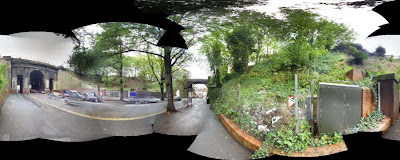
This is an especially cool diagram for relativity theory, but it's rather hard to find in print. There's a limited version of it in Moreau's 1994 "Wave front relativity" paper, and I put it in
the book (chapter 8), but I can't think offhand of anywhere else you're liable to find it.
It's simply an ellipse with lines radiating from one focus and converging on the other.
Imagine that you have a point-source of light giving off pulses. Surrounding the point-source is a spherical mirror, which catches the outgoing spherical EM wavefront and bounces it directly back to the source. All parts of the reflected wavefront arrive back at the source at the exact same moment.
This tells us
(a) that all parts of the surface are at 90 degrees to the source, and
(b) that all parts of the surface are at the same distance from the source.
=Relativistic Aberration=
Now let's replay the same situation, but imagine how it would have looked to us if we were whizzing past the experiment in a spaceship (but not so close that we actually disturbed the light in any significant way).
Now, the geometry seems to be different. We're forced to agree that the reflected wavefront still converges on the emitter (because nothing within the experimental region has physically changed), but since the light takes a finite time to go out and come back again, as far as
we're concerned, the experimental hardware has been moving while the light was out doing its thing.
For
us, the light was being emitted from one position and refocused at another.
And the shape that does
that is an
ellipse.
If we look at the shape of the relativistic ellipse, we find that the outgoing rays are angled forwards ... they
have to be in order for them to be able to keep up with the "moving" source. And if we measure the angles of these rays on the diagram, it gives us the textbook
relativistic aberration formula used by special relativity (and also by Newtonian optics, old ballistic emission theory, and any other relativistic model).
=Velocity-rescaling, distance and time under Special Relativity=
The thing that's slightly counter-intuitive about the diagram is that if the radius of the sphere is half a light-second, and if it's supposed to take exactly one second for the light to return to its starting point (so that the bouncing light makes a clock that supposedly ticks every second), you might expect the distance "
v" that the object moves in one second to simply be the distance between the two points. Slightly perversely, under SR, it isn't. The relative
proportional velocity v/c (velocity quoted as a fraction of the speed of light) has to be the ratio between the focal point distance and the stretched, longest dimension of the ellipse. So if the distance between the focii is half the length of the ellipse, we can say that the velocity is half lightspeed
(in the diagram above, it's 0.8c).
But since the ellipse is stretched, the distance between the points (if
v is defined as a particular fraction of the speed of light) is stretched, too. If we're to follow SR and say that lightspeed is a fixed
global reference, then the distance between bounce-points is somewhat
more than
v metres.
Under special relativity, the width of the ellipse is assumed to be constant regardless of velocity, the ellipse is stretched by the Lorentz factor (calculated from our proportional velocity), and the "point-to-point" distance ends up elongated by the Lorentz factor, too.
Under special relativity we explain the extra distance by invoking
Lorentz time dilation. We suggest that the particle travels further than expected in our coordinate system in one of its
own seconds, for a given nominal velocity, because its clock is running slow (so for us, it travels for more than a second,and crosses more than
v metres). Or we can argue that if an observer moving with the experiment sees a piece of paper with the diagram drawn on it passing by with the same proportional velocity of
v, that for them, the distance between the marks
is v metres, because their measurements indicate that the moving paper is
Lorentz length-contracted. The ellipse looks like a giveaway that lightspeed
isn't globally fixed, but if we assume that it
is, and need to explain why the ellipse somehow doesn't really
count as an ellipse, we end up with the traditional SR length-contraction and time-dilation explanations.
Contract the elongated ellipsoid by the magical
gamma factor, and its outline turns neatly back into the original sphere.
=Doppler shifts=The next thing that we can do is to look at the length of the lines. Turns out that, if we're doing the SR version of the exercise, each ray elongates or shrinks by precisely the right ratio for special relativity's
relativistic Doppler effect. The forward and rearward distances are stretched and squashed by the ratio SQRT[(c-v)/(c+v)], and the 90-degree-aimed ray is stretched in length by SQRT[1 - vv/cc].
That's the Lorentz
transverse redshift prediction of special relativity.
=Ellipses are Cool=So this one little diagram tells you almost everything that you need to know about special relativity. Once you've drawn it with the appropriate proportions for a given velocity, all you have to do is read off the angles and distances with a protractor and ruler to find SR's physical predictions about the appearance of a moving body, as seen from any angle.
If you'd prefer not to rely on any "odd" theory-specific definitons of velocity, distance or time whenbuildign the ellipse, all you have to do is draw in two rays from a focus, with lengths rescaled by the theory's particular Doppler shift predictions, and the rest of the diagram constructs itself. Along with the
Minkowski lightcone diagram, it's probably one of the most powerful diagrams in special relativity.
So why isn't it in the books?
We-ell, perhaps the problem with the diagram is that it makes people think. Which leads to troubling ponderings, because it turns out that the diagram doesn't
have to be used with special relativity. It'll compute the SR relationships if we deliberately stretch the point-to-point distance by the Lorentz factor, or if we use the SR "relativistic Doppler" relationships to define the reference wavelength-distances, or if we decide that lightspeed has to be defined as globally constant for all participants ... but if we're only interested in the principle of relativity, and we're not prepared to commit to these extra SR-specific things, the ellipse also lets us plug in other assumptions, and lets us see the their consequences.
For instance, we know that old Newtonian optics was technically a "relativistic" theory (although nobody could get NO to work properly with wave theory). We know the forward and rearward wavelength changes associated with that theory, so we can draw in these two wave-distances from one of the focal points, and construct the rest of the ellipse around these maximum and minimum radii. What we end up with is an exact duplicate of the SR ellipse, with the same proportions and aberration angles, but with an additional Lorentz magnification. All the NO wavelengths are longer than their SR counterparts by a Lorentz ratio. So transverse redshifts aren't unique to special relativity.
And then you notice some other things. The SR ellipse can be compacted back into its original circular outline just by contracting it on one axis. This is analogous to tilting the diagram off the page to produce a contracted "shadow", which gets us into the subject of
Minkowski spacetime, tilted
planes of simultaneity, and other cool things. The SR family of ellipses actually represents constant-width tilted cross-sections through a constant
Minkowski lightcone and can be visualised as projected
conic sections.
The SR version of the constructed ellipse is the only one that has this special property.
This tells us that if we require spacetime to be "flat" in moving-body problems, the SR relationships are the only ones that work. We're still freetoargue argue about the correct
philosophical interpretation and presentation of the theory, and about whether the interpreted contractions and clock-changes are physically real or not (and about what wemean by "physically real" in the context of SR), but the defining Doppler characteristics of the theory – the things that dictate the final physical predictions and equations ofmotion, regardless of interpretation – are set, locked and non-negotiable once we've decided that we won't be implementing curvature as part of the model. According to the ellipse, Relativity (limited to simple inertial motion) plus flat spacetime gives SR. It's airtight.
If we now go back to the enlarged Newtonian version of the ellipse, we find that the rules are different. The enlarged NO wavelengths can't be fitted back into the original sphere without distorting the centre of the ellipse out of the page. Instead of a tilted-and-rescaled cross-section through a fixed geometry (Minkowski spacetime) we end up with a geometry whose shape dynamically changes when there's relative motion between physical masses. Instead of a purely "projective" tilt, we have a real physical change of shape. The causal structure of the metric now depends on the presence and motion of physical bodies embedded with it. We end up with a gravitomagnetic theory, with a different form of lightspeed constancy to SR. And that's why nobody, including Einstein, could put together a sane-looking reference model for Newtonian optics that didn't go crazy when you tried to treat it as wave theory. Newtonian optics simply doesn't work in flat spacetime. The wavelengths don't fit.
I still think that it's a shame that they don't teach the relativistic ellipse in physics classes. It's a powerful tool, and a really handy device for demystifying special relativity. But perhaps it's
too powerful, and perhaps if you're trying to convince a class that SR is the only possible answer, a tool that suggests the existence of alternative approaches spoils the narrative.
 If you're wondering how to produce panoramic images and "360×360"-degree "bubble" images like the one used for the Airbus 380 website, there are three main methods:
If you're wondering how to produce panoramic images and "360×360"-degree "bubble" images like the one used for the Airbus 380 website, there are three main methods: The authors' research paper ("Automatic Panoramic Image Stitching using Invariant Features", Matthew Brown and David Lowe) goes into this in a lot more detail, with sample pictures.
The authors' research paper ("Automatic Panoramic Image Stitching using Invariant Features", Matthew Brown and David Lowe) goes into this in a lot more detail, with sample pictures.



 Computer graphics are fine, but the problem with programming a simulation of something is that often you only get out what you put in. You lose the element of surprise. So
Computer graphics are fine, but the problem with programming a simulation of something is that often you only get out what you put in. You lose the element of surprise. So 


